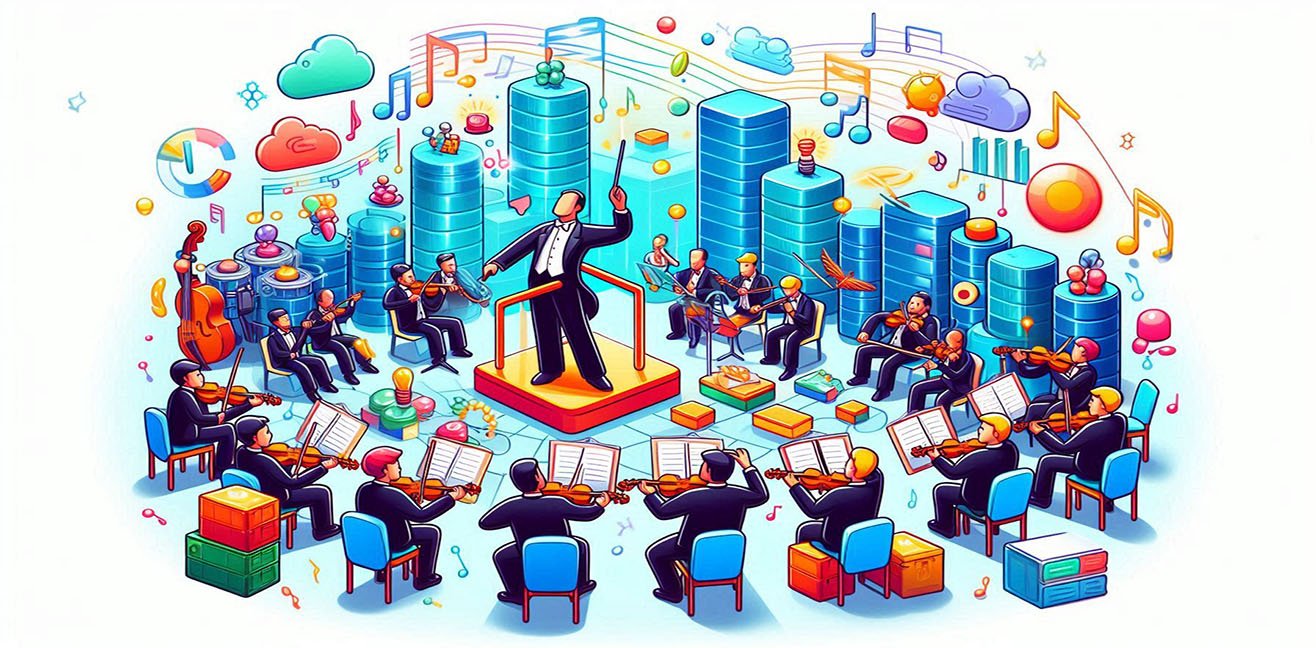Think about it, my love… If the world of computers is an orchestra, Kubernetes (K8s) is its maestro! 🎼✨
Each instrument (server) can play beautifully on its own, but without a leader synchronizing the orchestra, all you get is cacophony: pods play out of tune, nodes throw tantrums, and data gets lost… 😅
Kubernetes is a container orchestration system developed by Google — the superhero of the container world. But what’s a container? A container is a portable mini home that packages an application along with all its dependencies. Containers, brought to life with technologies like Docker, are organized and managed by Kubernetes.
🧩 Pods: Small Music Bands
The smallest deployment unit in Kubernetes is the pod.
Pod = a working group of one or more containers.
Containers in a pod share the same network and storage.
Think, my love: a pod is like a small room full of mini music bands:
- One has drums 🥁
- One has a guitar 🎸
- One has vocals 🎤
Important technical details:
- Pods are ephemeral, meaning they have a short life and can be scaled.
- Single pods are usually used for short-lived tasks and are scaled using Deployments and ReplicaSets.
Kubernetes acts like a maestro here: it ensures pods are distributed to the right nodes, balances the load, and automatically replaces a pod if it dies. 💖
🥁 Nodes: The Instrument Stands of the Orchestra
Node = the physical or virtual servers that host pods.
Kubernetes uses two types of nodes:
- Master Node (Control Plane) – the orchestra conductor, managing the entire orchestra.
- Worker Node – where pods live, i.e., the instrument stands.
Master Node components:
- kube-apiserver → command center deciding where pods will live.
- etcd → the heart of the cluster, storing all configurations and state information.
- kube-scheduler → digital Cupid assigning pods to suitable nodes.
- kube-controller-manager → controllers monitoring system state, e.g., controlling ReplicaSet count.
Worker Node components:
- kubelet → manages pods on the node and communicates with the master.
- kube-proxy → directs network traffic and ensures connectivity between services.
- Container Runtime → Docker or containerd, running the pods.
⚙️ Cluster: The Stage of the Orchestra
Cluster = the digital stage where all nodes and pods come together.
Without a cluster, your orchestra cannot perform; everyone plays separately, and the audience goes, “what is happening?” 😅
Cluster management in Kubernetes ensures:
- Load balancing
- Resource optimization (CPU, RAM, Storage)
- Self-healing (replacing broken pods)
- Automatic scaling (Horizontal/Vertical Pod Autoscaler)
🔄 Self-Healing: The Orchestra’s Health Check
Kubernetes’ superpower: Self-Healing.
- If a pod dies, Deployments or ReplicaSets create a new one.
- If a node fails, pods move to other nodes.
- StatefulSet pods are managed without data loss.
Kubernetes is the super maestro fixing wrong notes in the orchestra instantly! 🎵😎
🌐 Service and Ingress: The Concert Hall
- Service: abstraction allowing pods to communicate.
- ClusterIP → internal network
- NodePort → external access
- LoadBalancer → automatic balancing in cloud environments
- Ingress: controls HTTP and HTTPS traffic, like digital stage lights.
Even if pods change, Service and Ingress ensure your application always works and traffic is routed correctly. 💡
📈 Scaling & Deployment: Orchestra Rehearsals
- Horizontal Scaling: increasing or decreasing pod count → “adding new musicians to the orchestra”
- Vertical Scaling: giving more resources to a pod → “giving a musician a stronger instrument”
- Rolling Updates: deploying new versions without downtime → “silently replacing old parts with new ones in the orchestra”
⚡ Technical Tips and Fun Notes
- Namespaces: like different stages or concerts in the orchestra.
- ConfigMap & Secret: the hidden lyrics and sheet music for pods.
- Persistent Volume (PV) & Persistent Volume Claim (PVC): secure vaults for the orchestra’s valuable notes.
- Helm Charts: magical music sheets that deploy the entire orchestra in one click.
🎉 Conclusion: The Magic of Kubernetes
Kubernetes is the maestro of the container world, the orchestra’s conductor, the loving manager of data centers. 💖
Thanks to it:
- Containers work harmoniously
- Pods and nodes are organized
- The system is resilient to failures
- Modern cloud applications run smoothly
In short, without Kubernetes, the digital world descends into chaos; with it, you watch everything play in perfect harmony like a maestro. 🎼💻
💬 Closing Words
Servers play, pods dance, nodes stay in sync…
And you, dear reader, are watching the magic of this orchestra.
Next time servers throw tantrums or pods randomly move, remember: Kubernetes is always behind the scenes, silently conducting like a true maestro. 😎🎻




